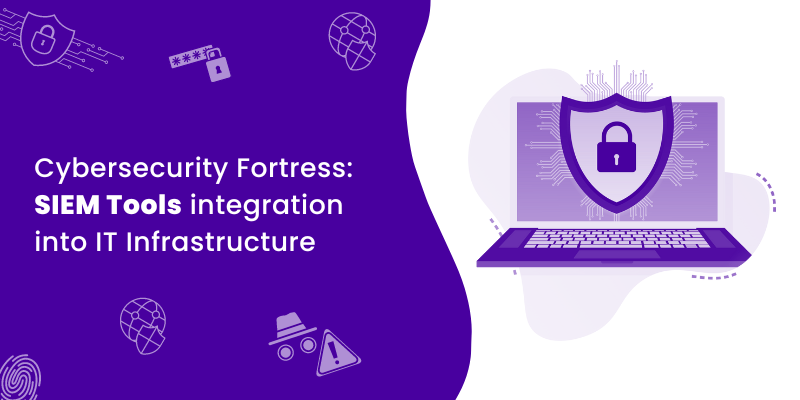Integrating SIEM Tools into IT Infrastructure to create a Cybersecurity Fortress

Integrating SIEM Tools into IT Infrastructure to create a Cybersecurity Fortress
Strong cybersecurity is vital in today's digital environment, where hackers lurk like wolves in the digital sheepfold. Furthermore, the Security Information and Event Management (SIEM) technology is the foundation of any effective defense. By offering a 360-degree perspective of your security posture and facilitating proactive threat detection and response, integrating a SIEM into IT infrastructure is like erecting a digital castle.
Why Use SIEM?Imagine a security analyst who is drowning in log files from several systems and is working frantically to put together a fragmented picture of possible dangers. That was life before SIEM. Presenting the SIEM, an effective tool that gathers and examines security data from all points of your IT infrastructure, including servers, firewalls, network devices, and apps.
With the help of SIEM, you can:
Identify dangers early on:SIEM highlights questionable activity before it develops into a major cyber disaster by connecting seemingly unrelated events into significant patterns. Consider it like an advanced digital security alarm system for your domain.
Conduct effective research:The days of sorting through log mountains like a worn-out prospector looking for gold are long gone. Like a pro investigator pursuing a cybercriminal, SIEM's user-friendly dashboards and search features enable you to promptly identify the location and extent of possible events.
Act effectively:Like a firefighter putting out a digital fire before it consumes your entire network, SIEM gives you the capacity to contain risks and limit damage before they severely impair your operations with real-time warnings and automated response procedures.
Boost compliance:By offering thorough audit trials and reports, SIEM assists you in adhering to industry rules and internal security policies. It's like having a careful accountant who keeps track of every digital dime.
Building the Fortress Walls: IntegrationThe strength of a SIEM depends on how well it integrates with your IT system. Here's how to make sure the connection goes smoothly:
Ingestion of Data:Select a SIEM that can readily absorb data from all your security and IT systems, independent of vendor or platform. Seek solutions that, like a chef with a well-stocked pantry of ingredients, have open APIs and flexible data interfaces.
Log Management:To guarantee accurate and timely data transmission to the SIEM, implement a strong log management strategy. For effective data analysis, think of log aggregation and normalization techniques as well-arranged bookshelves by a librarian. SIEM tools helps in implementing and enforcing log retention policies of ISO and other Industry standards.
Security Orchestration:Connect your SIEM to additional security solutions like endpoint protection platforms, firewalls, and intrusion detection systems. This makes automatic incident response and cleanup possible, akin to the seamless symphony of a well-oiled orchestra.
Threat Intelligence:Feed your SIEM with external threat intelligence feeds to keep ahead of changing cyber threats. This gives the SIEM the ability to recognize and rank suspicious activity according to the most recent attack patterns, much like a soldier getting intelligence on the whereabouts of an adversary.
SIEM integration has several advantages for IT workers
Enhanced Security Posture:SIEM gives you a comprehensive picture of your security posture, enabling you to spot weaknesses and put preventative mitigation plans in place—just like an experienced general scanning the battlefield and allocating forces appropriately.
Reduced Burden:Security analysts can concentrate on important duties by having automated alerts and response procedures to free up their time. This is like a busy doctor assigning nurses to perform basic exams while they handle complicated surgery.
Better Decision-Making:
Like a CEO evaluating market trends to make wise business decisions, SIEM data enables you to make data-driven judgments regarding your security investments and plans.
Streamlined Compliance:By offering thorough audit trials and reports, SIEM assists you in meeting compliance obligations. It's like having a careful accountant who keeps track of every digital dime.
Including a SIEM in IT infrastructure is a calculated investment in strengthening your cybersecurity posture rather than just a technical update. SIEM helps you create a digital fortress against constantly changing cyber threats by giving yexaou a unified picture of your security environment, enabling proactive threat detection and response, and optimizing your security operations.
A few examples of best SIEM are listed below:
Splunk Enterprise Security:A veteran in the field with robust features and powerful analytics.
Wazuh:It is a free, open-source security platform that combines XDR and SIEM functionality. It secures workloads in on-premises, virtualized, containerized, and cloud-based settings.
Fortinet FortiSIEM:It is a commercial SIEM with a more extensive set of capabilities and pre-built integrations.
IBM Security QRadar SIEM:Compliance champion with pre-built reports and intuitive interface.
LogRhythm NextGen SIEM Platform:AI-powered powerhouse for threat detection and incident response.
Looking for best cybersecurity services? please contact us.
